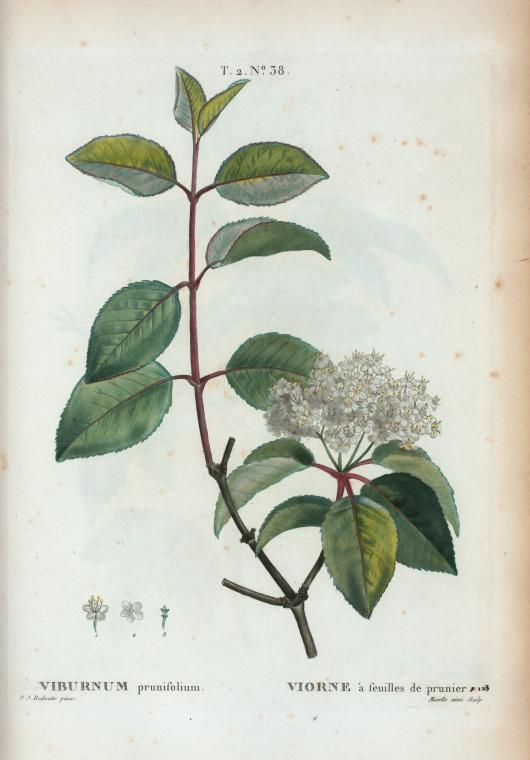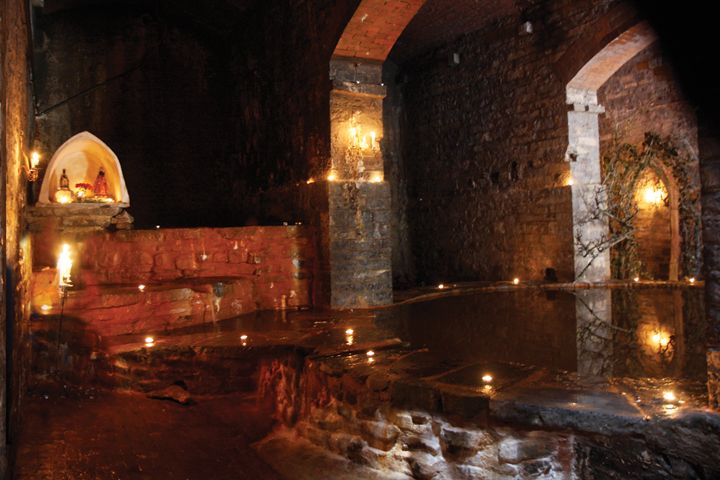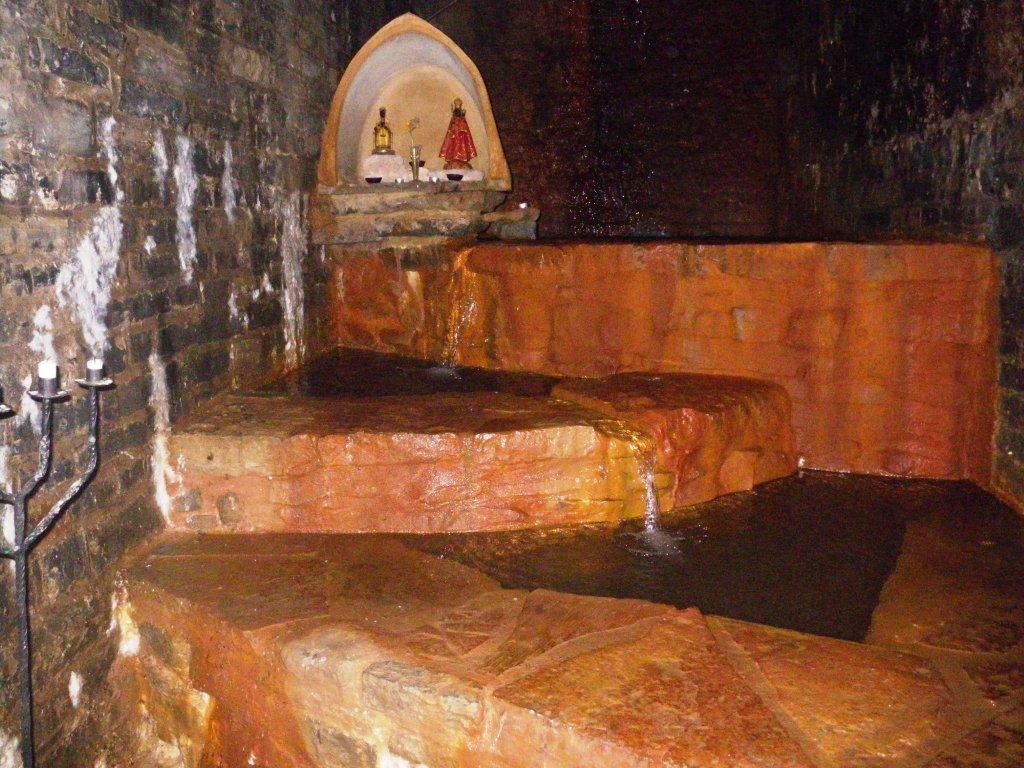Left: Hawthorn, Crataegus laevigata and Right: Blackthorn, Prunus spinoza
From Prof. Dr. Otto Wilhelm Thomé’s Flora von Deutschland, Österreich und der Schweiz 1885, Gera, Germany
Hawthorn and blackthorn are well known tree allies, and they play starring roles in much European folklore. Less known is the American-native, Blackhaw. When taken as a triumvirate, the three form a powerful spirit coterie. All three trees share a spiritual kinship with the Queen of Elfheim; Hawthorn the May Queen, Blackhaw the Mother of the Wood, and Blackthorn the Crone of the Forest. While it has become only a name for their fruit, “haw” began as an old English word for “hedge”, both in the literal sense of a bush planted at the edge of the property, and also as the liminal space between our world and the Other Place, and all three Mother Trees partake of this boundary place in different ways. She of Fruit and Thorn is a powerful tripartite ally for witches.
The three trees look very similar, although they are not as genetically related as once thought. All three are bushy shrubs or small trees with small berry-like fruits (called “haws”) and thorny branches. Their bark is smooth and gray (blackthorn’s is darker) when they are young, but becomes wrinkled with cracks as they age. They have small white flowers that bloom in profuse clusters early in the summer. These flowers attract clouds of bees, moths, butterflies, and other pollinators. Their fruits are bright red on hawthorn, and blue-black on blackhaw and blackthorn. These fruits are an important food source for wildlife, especially birds, squirrels, chipmunks, and mice. They overwinter on the tree, getting sweeter as they repeatedly freeze and thaw. Humans also eat the fruits, which taste a bit like cranberries and crabapples, often in the form of jellies and sauces. I have included some recipes at the end of the article.
Perhaps the most famous of the three, the hawthorn, is also called also the mayflower (after which the ship was named). Hawthorn is actually a wide variety of trees, all of the genus Crataegus. There are varieties native to Europe, Asia, and North America. Here, where I live in western Pennsylvania, the most common native varieties are the Pennsylvania hawthorn (which does not have thorns), the white hawthorn (the Missouri state flower), and the downy hawthorn (which blooms very early), although many other varieties, including the British-native common hawthorn are also widespread. Magically and spiritually, all varieties of hawthorn are more or less interchangeable, although, of course, not only does each individual species have its own totem, but every individual tree has its own personality.
Hawthorn’s abundant flowering branches are gathered by the handful across Britain, and used to decorate a variety of goddess-themed locales in early summer, including sacred wells and statues of Mary the Virgin. The famed Glastonbury Thorn, which blossoms in both summer and at Christmas time, is a variety of hawthorn, said to have sprung from the staff of Joseph of Arimathea, although the current tree is not that ancient one. The oldest tree in France, a hawthorn at Saint Mars sur la Futaie, was legendarily planted by St. Julien in the 3rd century. In his book The White Goddess, Robert Graves teaches that the Hawthorn was the great Goddess tree of pre-Christian Europe, although the scholarly bonafides of that theory leave something to be desired. What is, however, unquestionable, is Hawthorn’s association with the Other World across the continent. In the West of Europe it is said that the Hawthorn marks the entrance to Faerie, and it is considered extremely unlucky to cut the tree when it is not in bloom, or to bring hawthorn blooms into your home. They are of the wild, and inhabited by powerful spirits who do not abide being imprisoned within walls. In Eastern European myth, hawthorn is considered the best wood for vampire-slaying stakes. In the lore of the Chippewa people, hawthorn’s protective qualities are extolled. Once, Porcupine was being hunted by Bear. The clever Porcupine tied hawthorn branches to his back, and Bear was pricked all over by its thorns when he tried to take a bite. Nanabozho, a trickster god, is so impressed by Porcupine’s cleverness that he grants him thorns of his own, and that is how Porcupine came to have his quills.
Like the May Queen herself, Hawthorn is a powerful spirit ally, but one with whom all proper forms must be followed. Never cut a hawthorn which is not in bloom, and ask before taking flowers or fruit. Respect Hawthorn, and She will respect you. Hawthorn hedges planted around a home ensure that no malicious spirits can take up residence there, and encourage the favor of hobs and other helpful spirits. If you are lucky enough to have a hawthorn near your home, give it offerings of milk, honey,and fresh bread at regular intervals. This kindness will be repaid many-fold. The small thorns are excellent to use in love spells, where they can prick the hearts of lovers, as Cupid’s arrows might. The haws have long been used medicinally to treat high blood pressure and other ailments of the circulatory system, and they are just as good for magical healing of brokenheartedness. For this use, make a tincture of the haws, and anoint your heart with it daily. Hawthorn is an excellent wood for wands, and is a favored choice for hedge-riding brooms, although, personally, I prefer blackhaw for this.
Blackhaw, Viburnum prunifolium
From Duhamel du Monceau’s Traite des Arbres et Arbustes que l’on Cultive en France en Pleine Terre, 1801
Blackhaw, Viburnum prunifolium, is an amazing witch-plant native to the eastern United States, as far west as Illinois. Here in Pittsburgh, it grows as a bush, but further south it can grow into a small tree. Unlike hawthorn flowers, which can smell unpleasant, blackhaw flowers are sweetly fragrant, similar to honeysuckle (a distant cousin). In addition to being so pretty, blackhaw is an important healing plant, especially for women. It was traditionally used by First Nations healers for all sorts of women's health issues, including calming menstrual cramps, preventing miscarriage, speeding recovery from childbirth, and easing menopausal symptoms. Vance Randolph, in Ozark Magic and Folklore, says of it: “Blackhaw bark, according to the old folks, makes a tea that is useful in all sorts of ‘female complaints.’ It is good for scanty, irregular, or painful menstruation. Women going through the change of life consume large quantities of blackhaw bark, and this use of the stuff is so well known that there is a whole cycle of allegedly funny stories about it.” So powerful a preventer of miscarriage is blackhaw that is was often force-fed to enslaved women to prevent them from aborting (for which the women used the root and bark of the cotton plant). It is a powerful antispasmodic of the uterus, primarily due to the presence of scopoletin, which is a coumarin glycoside. HOWEVER, blackhaw also contains salicin (the same as aspirin is made of), which can sometimes cause birth defects. Pregnant or breastfeeding women should only take blackhaw after consulting with a medical professional competent in phytochemistry (such as a properly trained herbalist or naturopath).
Blackhaw is related to elderberry, and its spiritual nature bespeaks that kinship. Like Elder, Blackhaw is Mother of the Woods, and the spirits of the plants almost always appear in the form of a woman. Like the other Haw plants, blackhaw it is a hedge-plant. In the garden, Blackhaw is best used at the edges of your property, where its liminal character and sharp thorns provide a wall of protection. It is extremely easy to grow in its native East; tending to hedge-like thickets in the north and small trees in warmer climes. However, Blackhaw can be invasive in the west, and caution should be taken when planting it there. Mother Blackhaw is an excellent ally for hedge-riding and other forms of spirit journeying; ask her to teach you. In some parts, Blackhaw is sometimes referred to as “Wayfaring tree” although that name more properly belongs to the closely related European Viburnum lantana. I suspect it derives this name not only from its propensity to grow in roadside ditches, but also in acknowledgement that Mother Viburnum can help you find your way in the Other Places.
In the South, the dried roots of Blackhaw are sometimes called “Devil’s Shoestring”, but most often that name refers to Mother Blackhaw's cousin Viburnum alnifolium. The roots are most often used for protection spells. One way to use them in this way is to take nine roots, and bind them around with red or white string, making nine knots as you do. Bury the bundle near your front door, or hang it on the wall above a door. This use is strikingly similar to the European use of Blackthorn which, like Blackhaw, is called Mother of the Wood. You can also take that same bundle and soak it in whiskey or rum to make a cologne that brings luck to gamblers. The thorns of Mother Blackhaw can be used as pins to pierce poppets of your enemies, or as protective swords to keep trouble at bay. However, they are not as strong, large, or poisoned as those of Blackthorn (see below), and so I prefer those for such work.
The European cousin of blackhaw, Viburnum opulus, is called “guelder-rose” or “May Rose” in English and “Kalyna” in Ukrainian. The two plants are similar, but kalyna’s leaves are deeply lobed and the drupes are red instead of blue-black. Viburnum opulus is occasionally sold in America as an ornamental plant; please do not plant it, it is highly invasive, and displaced native species like blackhaw and highbush cranberry. Plant blackhaw, American highbush cranberry (Viburnum trilobum) or a native hawthorn instead. Complicating this is the fact that highbush cranberry is sometimes labeled as guelder rose, and sometimes even labeled Viburnum opulus. Ask a knowledgeable local gardener to identify the plant if you cannot.
In Ukraine, the bright red drupes of Kalyna are a symbol of blood-ties, and so the kalyna tree is a symbol not only of the shared ancestry, but also the solidarity, of the Ukrainian people. Kalyna plays a very important role in Slavic paganism, and in modern Ukrainian culture. In myth, Kalyna, whose name comes from the old Slavic name for the Sun, are immortal world-trees, connecting our world to the Other Place, and birds that eat the berries can carry news to and from the beloved dead. In modern Ukrainian, the phrase “walking down the kalyna bridge” means to fall in love. Kalyna bushes are thought to grow on the graves of fallen heroes, whose spirit moves into the plant. However, it is also the virgin’s blood which is symbolized by the kalyna, which plays a prominent place is folk traditions surrounding weddings.. In Chervona Kalyna: and Ethnobotanical Study, it is theorized that kalyna thickets were gathering places during the summer solstice (Kupalo) festival. There, the young women wore wreaths of fresh kalyna flowers, and the young people spent the nights cavorting and pairing up. There are many Ukrainian folk tales about kalyna. Hers is one:
Once upon a time, there was a girl, who was in love with the blacksmith. However, the blacksmith did not even notice her. The girl grew desperate. She followed him, and discovered that each morning, he went into the forest, and gathered wood to feed his forge. The girl, in her madness, decided to burn down the forest, to capture the spirit of the blacksmith. And so she did. The next day, the blacksmith set forth, but found his favorite grove reduced to ashes, save for a single kalyna tree, beneath which sat the girl, weeping desolate tears. Seeing her amidst the white flowers, the blacksmith too fell in love, but it was too late. The spirits of the woods had hold of the girl, and there before his eyes her youth and beauty withered like the forest reduced to ash. Saturated with her bitterness, the kalyna berries were never sweet again.
Magically, Mother Blackhaw is a great ally, whose character is somewhat between Hawthorn and Blackthorn. She is a fierce protector of women and children, and an excellent intercessor in all types of necromantic work, but especially those with beloved ancestors.
Blackthorn (Prunus spinosa) has no variant native to the Americas, although it is naturalized in parts of the United States and Canada. It has bright red blood-like sap, large blue-black fruits called “sloes”, and long savage thorns. Wounds made by blackthorns are given to sepsis (blood poisoning), so be careful when you work with this plant! In Northwestern Europe, blackthorn is a quintessential hedge plant; it’s vicious thorns will even hold back stampeding cattle. In fact, if you imagine a fairytale hedge of thorns, like that in Sleeping Beauty, I assure you that the plant you are picturing is blackthorn. Blackthorn is an excellent protective ally, and is equally good for offensive work. The famed Irish fighting sticks called shillelaghs are made from blackthorn, as are many traditional blasting rods. Blackthorn are the traditional home of the Luantishees. Blackthorn are a winter plant; a cold snap in early spring is called, in traditional British English, “blackthorn winter”, and in Irish myth, winter begins when the Cailleach strikes the ground with her blackthorn staff.
Blackthorn is a witch ally par excellance; blackthorn walking staves are an important traditional tool in traditional witchcraft, and the blackthorn stang is the tool of choice for many curses. Perhaps the most classical magical use of blackthorn is using the thorns to pierce poppets of enemies, or even pieces of paper upon which the enemy's name is written. Like blackhaw, blackthorn bundles are tied with red thread and hung above doorways as protective amulets. At Mastros & Zealot: Witches for Hire, one of our best sellers is protective witch bottles made with blackthorns. To make one yourself, start with a small, tightly sealing bottle, into which you should place three blackthorn thorns, some ground dragon’s blood resin, several dried blackhaw drupes or elderberries, chips of golden rutilated quartz (whose long golden “hairs” ensnare curses), small mirror shards, a few small blue glass “evil eye” beads, some sloe gin, and whatever else feels right to you. Top the bottle off with your own urine. If desired, you can also include a small figurine of a dragon (which can be found in the toy section of many dollar stores). As you add each item, speak to it, awakening the spirit within and charging it to protect your home. It is best to do this work on a Saturday when the moon is waxing. Give your bottle a name. Place the bottle near your gate or door, and whisper hello and goodbye to it by name as you go past, and thank it for keeping you safe.
Heartwarming Tea
1 Tbsp hawthorn haws
1 Tbsp rosehips
2 inches cinnamon stick
Simmer about 15 minutes in clean water, and then strain. Add honey to taste.
Blackhaw Sauce
2 oranges, sliced thin and de-seeded
4 cups blackhaw drupes, cleaned and de-stemmed
3 Tbsp lemon juice
3 cups sugar
Garam masala spice mix to taste (if unavailable, use pumpkin pie spice and add some black pepper)
Simmer orange slices until soft. Crush berries with a fork or potato masher (NOT a blender), and strain to remove seeds. Combine all ingredients and mix well. Simmer over very low heat until thick. Excellent with poultry, beef, or venison, or anywhere cranberry sauce would be used. Will keep refrigerated for about 2 weeks. You can also make this recipe with hawthorn berries or blackthorn sloes.
Sloe Gin
1 lb fresh blackthorn sloes.
1 cup superfine sugar (or put regular sugar through a coffee grinder)
1 liter gin in a glass bottle
another clean 1 liter glass bottle
Not traditional: I like to add cloves, cinnamon, and orange peel as well.
If your sloes are dried, soak them until they’ve plumped up. Put the sloes in the freezer until they are frozen hard, and then let them defrost at room temperature. This will sweeten them, and also crack the skin, making it easier for the gin to penetrate. Pour approximately half the gin into the other bottle. Add the sugar, half to each bottle, and shake well to dissolve. Add the sloes, until the bottles are as full as can be. Store somewhere dark and cool, shaking the bottle every few days for the first week, and then once a week (on Saturdays is magically ideal) for several months. If made at the time of the Autumn Equinox (as is traditional) the gin will be ready at Christmas, but the longer it soaks, the better, and redder, it will be.













































